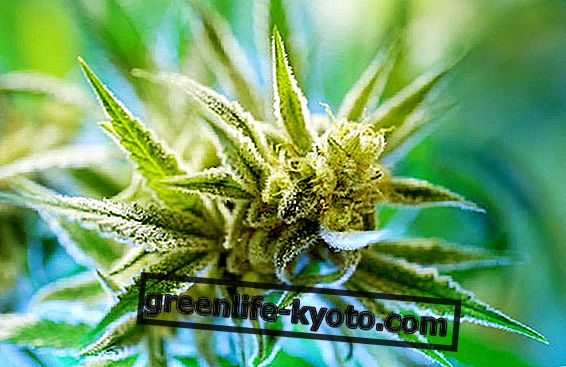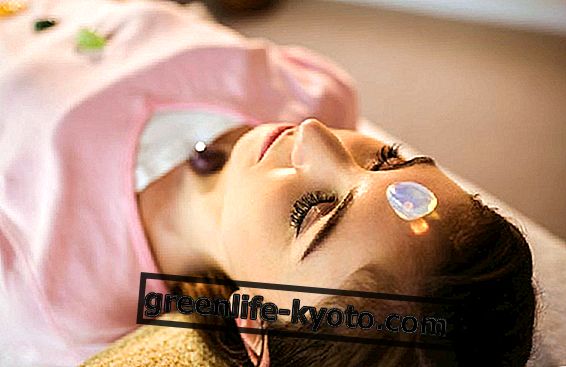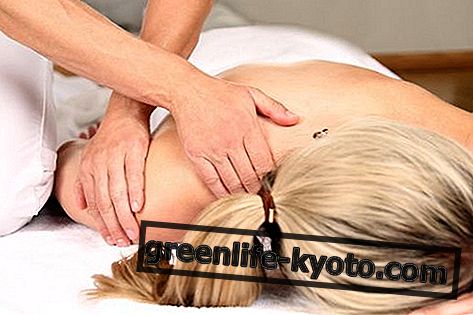
The term " depression " comes from the Latin " depress", that is, press down; in the current sense, this term is not used to indicate a real pathological condition, but rather a particular state of mind, quite complex, mixed with sadness, melancholy, absence of joy of living in various degrees, which the patient accuses following traumatic events (mourning, accidents, but also births etc) or particularly important in his life, which leads him to consider himself inadequate to the situations, insecure, discouraged, until arriving, in the most acclaimed stages of this condition, to develop feelings of real irrational fear for the future, which negatively affect social life and relationships, accompanied by physical and mental symptoms such as anxieties, obsessions and phobias.
Historically it is traced back to the Greek physician, geographer, astrophysicist Hippocrates of Kos or Kos (460 BC-377 BC), the father of Hippocratic medicine, the first descriptions of melancholia (from the Greek μελαγχολία), as a distinct disease, with characteristic symptoms. Since then this term often appears associated with mood disorders, but the first reference to a psychiatric symptom is due to the French psychiatrist of the nineteenth century Louis Delasiauvene (1804-1093), known for his studies on epilepsy, which he followed Emil Kraepelin (1856-1926) brilliant and illustrious German psychiatrist, whose name is associated with the study of early dementia and manic-depressive psychosis.
The depressive pathology, identified by Kraepelin, was characterized by the alternation of depressive manifestation and euphoric excitement, with symptoms of depression of the mood, fixed ideas and absence of will or abulia. The depressed subject, as described by the German psychiatrist, is an individual predisposed to pathology, from particular socio-environmental conditions, who cannot free himself from the vicious circle of sadness and gloomy thoughts; the world, which sees, is gloomy, made only of pain and suffering, in which in the end it is not worth living (suicidal obsessions).
But it is certainly Sigmund Freud (1856-1939), Austrian neurologist and father of psychoanalysis, the main architect of the recognition of depression as a pathology. In fact, he compared the state of melancholy to mourning (Mourning and melancholy 1917), thus theorising the mechanism by which the concept of "loss" for a death or for the end of a love, inexorably translates, through an unconscious process, in a "loss of the subject", which the depressed individual identifies with the "if" (the Freudian ego), deriving serious melancholy symptoms, accompanied by feelings of guilt, inferiority and inadequacy towards the various situations, which can lead to in psychotic-depressive symptoms.
Subsequently numerous researchers, in the mid-twentieth century, dealt with the "depression problem" by providing a series of classifications contained in the statute of the Diagnostic and Statistical Manual of Mental Disorders (DSM-I, 1952) focused on the "depressive reaction", while the subsequent DSM-II (1968) is inspired by "depressive neurosis" as a pivotal symptom; these were followed by other systematizations, among the most recent (DSM-IV, 1994), we can remember the subdivision into two groups: unipolar and bipolar depressive disorders, to which the Classification of Disease and Realeted Health Problem 10th Edition was associated (ICD -10, 1992) of the WHO which recognizes the same criteria.
Depression, therefore, understood as a pathological form, belongs to mood disorders, along with mania and bipolar disorder; it can present itself as a single transient episode or, defined as a depressive episode, or it can take more lasting and structured forms, such as those of a real depressive disorder even of a greater type when the symptoms are such as to compromise the social adaptation of the subject . This major disorder is characterized by lasting symptoms (over two weeks), which cause a significant impairment of the socio-relational, work or other psycho-emotional areas, whose main symptoms can be summarized as follows:
- Depressed mood persistent over time eg. sadness and maliconconia for days.
- Apathy or loss of interest or pleasure for all or almost all the activities lasting over time.
- Agitation or, on the contrary, psychomotor slowing down, fatigability and asthenia.
- Significant decrease in weight or, on the contrary, hyperphagia.
- Presence of psychosomatic disorders es.gastriti, frequent headaches.
- Anxiety disorders including mainly panic attacks ..
- Insomnia or hypersomnia.
- Listlessness, abulia, loss of personal motivation, the ability to think or concentrate and make decisions.
To these are added important psycho-affective symptoms: 9. Decreased self-esteem, tendency to isolation and loneliness, restlessness, impotence, resignation, distrust. 10. Feelings of disappointment and pessimism about the future, negativism, frequent tendency to cry, sense of failure, discouragement or despair, alternated with feelings of guilt, resentment and brooding.
11. In the most serious stages anxiety and delusions appear with a detachment from reality, accompanied by frequent thoughts of death and recurrent suicidal ideations.
These symptoms are not all present simultaneously, but have an individual variability, moreover, the course of the pathology is slow, but tends to worsen over time if not adequately treated.
For the diagnosis of a major depressive episode the presence of at least five of the symptoms listed above is recognized as fundamental, also in consideration of the fact that this form, in half of the cases, does not remain an isolated episode, but is repeated over time leading to the formation of a real depressive disorder.
A classification of the various forms of depression can be summarized as follows:
- Reactive depression to a triggering event (mourning, loss, separation, failure, disappointment, violence).
- Endogenous depression from unconscious patient-related causes (genetics, personality).
- Anxious depression (eg panic attacks).
- Psychotic depression severe form of depression with symptoms of psychosis (eg.deliri).
- Adaptation and mood disorder.
- Postpartum depression.
- Secondary depression due to various types of neurological, organic or pharmacological diseases, degenerative neurological disorders, tumors, LES etc, to name a few.
- Bipolar disorder alternating major / minor depressive episodes with manic / hypomanic episodes.
From the Epidemiological point of view depression, according to recent data from the WHO (2012-2014), is a widespread pathology, which affects more than 350 million people of all ages, all over the world; moreover, the data show that this pathology is not always recognized and treated properly, it is estimated, in fact, that less than 10% of depressed people receive adequate care.
In Italy the data concerning the prevalence rates of mental disorders are those collected by the European project European Study on the Epidemiology of Mental Disorders (ESEMeD, 2004), in which Italy is present alongside 5 other European countries, in the field of of WHO World Mental Health (WMH) Survey Initiative. According to this survey the most common disorders were: major depression (10.1%), specific phobias (5.7%) and dysthymia (3.4%), followed by post traumatic stress disorder, phobia social and generalized anxiety disorder (in about 2% of respondents); the age of onset is concentrated around the age of thirty, while not sparing children and adolescents. Prevalence is greater in women and in the elderly population (over 65 years of age).
The conclusive data of the ESEMeD research have thus highlighted how about three and a half million adults have suffered from a mental disorder in the last 12 months: almost two and a half million have presented an anxiety disorder, a million and a half affective disorder and almost fifty thousand an alcohol abuse disorder ; moreover, the data underline that some groups are much more at risk of depression: women, unemployed subjects, housewives and disabled patients.
More recent data from the National Institute of Health ( Cnesp-ISS), Surveillance System on Depression-Steps (2011) show that depressive symptoms affect 7% of the adult population from 18 to 64 years of age. They confirm that women (9%), people with financial difficulties (16%), the unemployed (9%), those who live alone (10%) and those who suffer from chronic diseases (14%) suffer the most. . Finally, according to the WHO projection data (Mathers CD. Et al. 2006), it is estimated that in 2020 depression will be the second cause of disease, after cardiovascular diseases and in 2030 the depression will be identified as a second cause of disease worldwide, after HIV infection.
This brief "excursus", far from wanting to be a psychology treatise, to which we refer for every discussion on the themes of this protean pathology, wants to highlight an important aspect of the therapeutic possibilities of depressive disorder .
In fact, in the treatment of a widespread and often misunderstood mental disorder, such as depression, all the signs and symptoms manifested by the patient become more and more important, signals, often, of a hidden, profound pain that fails to emerge and manifest itself at the consciousness; it is therefore appropriate, for the well-being of the patient, to use all the available therapies, whether conventional or Allopathic (tricyclic antidepressants, I-MAO or monoamine oxidase inhibitors, second generation antidepressants or SSRIs etc.) variously suggested due to the symptoms act, both the unconventional or complementary ones such as the Homeopathic and the Acupuncture, which are well integrated, due to their synergism of action, with traditional therapies, reaching the double benefit of progressively bringing the patient to an improvement of the accused symptoms and tone mood on the one hand, and succeeding on the other to diminish progress
doses of allopathic drugs, the most heavily burdened with even important side effects.
The therapeutic possibilities in Complementary Medicine
In the Homoeopathic approach to depression, active principles are used, the "remedies" of Hahnemanniana memoria, which can be well included in the typological structure of the depressed subject, whose symptomatological and character framework (see L.Tocalli : The Constitutions in Homeopathy : critical and reasoned revision, 2014), can allow the personalization of care, a fundamental element of Homeopathic Medicine, and thus obtain the choice of a correct therapy of this pathology so closely related to the patient's experience and psychology. The categorization is, in fact, conducted through careful and accurate listening to the patient's anamnesis, which can guide the choice of the most suitable drug in the wide range of the homeopathic repertoire.
In Homeopathy the remedies used, precisely because of the profound symptoms that depressive pathology entails, in most cases, are those with high and medium-high dilutions (30 CH, 200 CH), ie those with greater dilution, which have a slower, but deeper action, due to the patient's symptomatology.
The following are some of the Homeopathic Remedies listed in alphabetical order for the treatment of depression, again based on the patient's symptomatological similarity :
Arsenicum album
or Arsenic anhydride is a powerful poison in nature if administered in weight dosage, in homeopathy it is appropriately diluted and used in subjects sensitive to the medicine for multiple acute and chronic pathologies, especially of the Psoric Reactive Model (see L.Tocalli : Homeopathy: the Models) Reagents, 2014). In this important constitutional remedy the depressive disorder is accompanied by a strong anxiety caused by various fears: for one's health, for death or for a serious incurable disease. The subject Arsenicum for his character fears loneliness, which makes him sad, melancholy and prone to thoughts of death.
The depression that responds well to this remedy is represented by a great uneasiness that becomes anxiety and manifests itself especially at night .
Pignolo, meticulous, precise, orderly, even stingy, the subject who responds well to the remedy is always wary and fears being deceived; he is pessimistic, he sees everything black and he always thinks of the worst, emotionally he alternates excitement with depression, moreover, he lives guilt and presents suicidal tendencies in many cases.
The depressive state can follow chronic and debilitating diseases, so much so that the subject often appears prostrate, weak, fatigued and strongly cold . Equally characteristic is the almost maniacal search for order and cleanliness, which underlie the need for security and reassurance.
The other main clinical indications of the remedy are for the gastrointestinal system: diarrhea, colitis, gastritis, gastroduodenal ulcer; at the level of the respiratory system: otalgia and asthma crisis; at urogenital level: cystitis and vaginitis; for acute skin infections: boils, hives, shingles and in some neuralgic disorders. Important features of the Arsenicum remedy are the burning symptoms and also the agitation and restlessness that causes patients to move continuously and walk for relief.
Arsenicum is often indicated also in the depression of the elderly for their characteristic psycho-physical weakness.
Aurum metallicum
The properties of metallic gold have been known since ancient times in China and Egypt; its therapeutic use dates back to Discorides Pedanio (40 BC) physician, botanist and Greek pharmacist, who practiced for a long time in Rome. The use, as described by Hahenemann, of "gold in powder" was part of medicines for melancholy and psychism characterized by hyperactivity, irritability followed by depression and disgust for life.
The depression of Aurum or Adult depressive syndrome is often the consequence of a severe affective trauma or of an exasperated state of mental fatigue.
You may find hypomanic access alternating with periods of depression; in the child character disorders occur with violent anger disproportionate to the cause, while in the elderly the depressive manifestations, more easily masked, are represented by the psycho-physical slowdown.
The subject who responds well to the remedy has the characteristic signs of the medicine: it is plethoric, irritable and impulsive, it is choleric ; alternates periods of joy with depressive crises, blames himself easily and lacks self-confidence, is discouraged and when everything seems insurmountable he is led to desire death (suicidal ideation).
The other main clinical indications of the medicine are: the cardiovascular syndrome with hypertension, extrasystoles and coronary insufficiency; hot flashes, cephalic congestion, vertigo and violent palpitations with an anxious state: "the heart stops"; fetid breath, burning heat, swelling and stabbing pains at the right hypochondriac with hepatomegaly (cirrhosis due to chronic alcoholism), bleeding hemorrhoids; chronic sinusitis; conjunctivitis and ocular hypertension; rheumatic pains in the extremities worsened at night and in winter (characteristic modalities of the medicine), as a consequence of periostitis or chronic osteitis of the short bones.
Ignatia amara
O Fava di sant'Ignazio is the remedy of choice for all reactive depressive states resulting from affective shocks caused by mourning, separation, sentimental or working disappointment .
The medicine can therefore be prescribed in all conditions in which the neurovegetative system is attacked where: fear, fear, annoyance, harassment, anger, sorrows, grief, disappointment, panic are the key symptoms. At the base of these depressive symptoms are often annoyances or disappointments in love, family conflicts, insults or unjustified reproaches, as well as repressed indignation for a long time.
The subject who responds well to the remedy is hypersensitive, presents paradoxical and contradictory symptoms ; cheerful, under stress or in case of opposition, he becomes sad, sighing, easy to cry, has mood swings, broods in solitude for a long time; worse with consolation.
He also suffers from emotional tachycardia, spasmodic cough and spasmophilia. The Ignatia subjects are people "torn and torn" who present functional spastic and psychic disorders due to strong emotions, worries or sorrows that they consider insurmountable.
The remedy is indicated in all the changing and paradoxical manifestations of hysteriform nature: hysterical globe, sighs, spastic colitis, spasmodic coughs, etc.
Natrum muraticum
It is sodium chloride (NaCl) or sea salt an essential cellular component, it is a remedy suitable for depression after severe and repeated emotional or emotional stress due to serious sorrows and disappointments in love. The remedy Natrum muriaticum belongs to the Tuberculin Reactive Model subgroup of the Psoric model, typical of subjects with nutritional disorders such as children, adolescents or young adults . ù
The subject who responds well to the medicine is sad, discouraged, uneasy, does not communicate, but constantly mulls over his sorrows, seeks solitude and does not like to be consoled, but above all, fails to externalize his feelings.
The repressed aggressiveness that is generated creates an excess of stress which in turn causes the depressive crisis with its symptomatic outfit . On a character level the subject Natrum is irascible, agitated, clumsy; thin (in the upper part of the body), pale, cold, very reserved; suffers from strong pulsating headaches, can present alopecia and oily hair.
Other indications of the medicine are: the convalescence of acute debilitating diseases, respiratory allergic disorders (rhinitis, sinusitis, nasopharyngitis) and cutaneous (hives, acne, herpes), stubborn dyspeps or constipation.
Phosphoricum acidum
Chemically it is the concentrated phosphoric acid H3PO4. It is the remedy of affective shocks resulting from serious sorrows, grief, love disappointment, intellectual fatigue and psycho-physical exhaustion.
The subject that finds benefit from the remedy in question is a long-limbed individual, with bone disorders related to too rapid growth and possible phosphorus and calcium deficiency, which can present long and difficult convalescences after debilitating diseases, or excessive intellectual fatigue (typical of students), which has completely exhausted its psycho-physical energies and develops a reactive depression.
The patient Phosphoricum acidum is incapable of thinking, of doing intellectual work; has a weak memory, suffers from daytime sleepiness, has diarrhea and strong sweating, great asthenia, suffers from occipital headache or neck pain with vertigo.
The main indications of this medicine are also: the headaches of adolescents and intellectually tired students; acute or chronic diarrhea with flatulence and abdominal dilation; bone growth disorders.
sepia
The medicinal product Sepia comes from the "cuttlefish ink", that is the dark liquid emitted by the animal in case of danger; this liquid is rich in amino acids, taurine, trace elements and enzymes.
The remedy is particularly indicated for subjects who present with dysfunction of the central nervous system and neuroendocrine system, which is manifested by a reactive depression characterized by the alternation of an asthenic depressive phase characterized by hypochondria, indifference to one's work and family members, frigidity, arterial hypotension, crying and desire for solitude; and of another stenic phase with hyperactivity and / or irritability, anger with possible violent acts.
The subject Sepia is often an apathetic woman, dissatisfied with her family and affective life, indifferent to everything, who is bored and refuses social life. In alternate periods, often in women during menstruation or in menopause, it can manifest uncontrolled anger attacks for futile reasons; frequent is also the sensation of heaviness in the small pelvis (due to venous congestion) and the sense of epigastric emptiness, accompanied or not by nausea, with aversion to the sight and smell of food; Frequent is the presence of intense and widespread hot flashes, as are frequent headaches especially left (typical laterality of the medicine).
Reactive depressive syndrome is typically a consequence of anxiety-provoking situations caused by continuous setbacks, disappointments, sorrows, severe emotional stress or secondary to post-partum or menopause. The Sepia subject desires solitude, does not want to be consoled and easily isolates himself, has a sad look and cries while telling about himself; the color is pale, the eyes are circled; lipotimies and varicose veins of the lower limbs are frequent.
Other clinical indications of Sepia are: hepato-digestive pathologies such as dyspepsias, biliary dyskinesias, constipation, haemorrhoids and gravid nausea; genitourinary infections (leucorrhoea, vaginal mycosis), uterine prolapse, dysmenorrhea and frigidity; respiratory diseases such as asthma or chronic bronchitis with greenish-yellow sputum; eczemiform skin disorders, Herpes type 1 - 2 and Psoriasis.
silica
Or colloidal anhydrous silica is a very important constitutional remedy, which ranks between the Psoric-Tuberculin Reactive Model for the tendency to recurrent infections and poor response to medicines and the Sicilian one for the chronicity of ENT infections and the tendency to depression in general. The subject Silicea is thin, weak, insecure, anxious and hypersensitive, fearful and unstable; presents a delicate constitution accompanied by a great physical and mental fatigue which translates into a general exhaustion of the organism, with attention and memory disorders, associated with the difficulty of managing its projects; sleep disturbances can coexist with sudden awakenings and sleepwalking. In particular, children and adolescents of the Silicea typology are nervous and agitated, fearful and timid subjects, who have a state-weight delay and often suffer from chronic occipital headaches and intellectual fatigue.
The characteristic depression of Silicea is therefore, linked to the exhaustion of vital energy and to the low self-esteem of the subject, who feels tried and discouraged to face life.
On the somatic level, Sepia has a tendency to recurrent infections of ENT mucous membranes (otitis, rhinitis, nasopharyngitis and angine), of the eye (stye), of the respiratory system (bronchitis, pleurisy, silicosis etc.), recurrent cystitis and urethritis; rickets, atonic constipation and intestinal parasitosis.
Pulsatilla
O Anemone Pulsatilla perennial herb of the Ranuncolaceae family is an antispasmodic, antineuralgic, emmenagogue and sedative remedy from the phytotherapeutic point of view. Pathogenetic experimentation and homeopathic clinical observation has allowed us to see how the main actions of Pulsatilla are performed on the respiratory and digestive mucous membranes, on the genital apparatus, on the venous system and on mood.
The subject Pulsatilla, often cries for futile reasons or while recounting its problems, is a very timid subject , highly emotional and in need of affection, anxious above all for new things, with a changeable mood, is very insecure and seeks consolation in others, comfort and understanding.
These subjects are people with many contradictions, generally timid and amiable, they seek the attention of others, but sometimes they become suspicious and even jealous and angry.
The main clinical indications of Pulsatilla are included in changing symptoms such as their mood: respiratory diseases (colds, nasopharyngitis, catarrhal bronchitis); digestive affections with dyspepsias and intolerance to fats, intestinal colic, alternation of constipation and diarrhea; gynecological diseases with menstrual disorders in women (pre-menstrual syndrome, leucorrhoea); affections of the venous system (congestion and venous stasis with varices); cutaneous affections (morbilliform rash, urticaria) and infectious diseases such as measles, rubella and mumps.
Thuya occidentalis
O "tree of life" is a widespread plant of the Cupress family and cultivated for ornamental purposes. Its pathogenesis is that of the Sicilian Reactive Model in which the formation of benign tumors, adipose tissue inhibitions, chronic infections of ENT mucous, respiratory, digestive and genital are characteristic, with slow and progressive onset of symptoms and a general tendency to secondary depression.
The subject Thuya is robust or "infiltrated" with frail legs, oily and greasy skin, with disseminated warts; he is introverted, suffers from a sense of inferiority and does not like talking about himself, also masks his feelings and often presents an obsessive type of neurosis with persecutory fixations and fixed ideas; strongly fears diseases and tumors.
It often presents a reactive depression / secondary to the chronicity of its disorders.
This remedy is generally prescribed for psychosomatic-based reactive depressions. Other typical symptoms of the remedy are dermatological disorders (warts, papillomas, juvenile acne, etc.), pathologies resulting from vaccinations, antibiotics or oral contraceptives, prostatic hypertrophy, bladder polyposis, chronic urinary tract infections, neuralgia and cenestesia.
Acupuncture in the therapy of depression
Depression in Traditional Chinese Medicine (TCM) is not understood as in the West as a well-defined and classified pathology, but is more easily identified with a particular state of punishment of the Spirit ( Shen ), coinciding with our "existential malaise" or "Bad to live", where all the emotional variations and frustrations have a pathological significance, that is, they are endogenous pathogenic factors that attack the individual as a whole.
The mood changes, in fact, are responsible for an alteration of the emotional balance, which causes the stagnation and the slowing down of the main vital factors of the organism and, therefore, of the main circulatory energies: in particular of the Qi or immaterial vital energy and Xue or material energy or " blood".
It should also be noted that in TCM the Shen is more properly understood as the mental, psychic, spiritual aspect that moves and animates the unity of man through the harmonious and joint action of different components, the emotions which include the same Shen or spirit o vital consciousness - Hun or spiritual soul - Po or bodily soul - Yi or reflection, purpose - Zhi or will, with their relative locations, such as the liver, where the Hun reside, is related to emotional tensions and anger ; the spleen ( Yi ) finds correspondence in reflexivity and its alterations are the obsessions. The heart is instead, the emperor organ, seat of the Shen, which dominates the emotions and joy is its main emotion; The kidney, home of the Zhi is the organ linked to emotional shocks and emotions such as fear or terror ; finally The lung, home of the Po is linked to the feeling of sadness .
According to the MTC, the exasperation of an emotional state causes, therefore, an energetic imbalance of the organ to which the feeling corresponds . Thus anxiety, fear, anger, sadness, etc., are manifested by an alteration of the energy flow, causing an energy deficit of the reference organ, making it more vulnerable to the pathology.
We can take the case, for example, of anger, that if prolonged in time it leads to the alteration of the emotional function corresponding to the connected organ, ie the liver. In fact, the subject that easily transcends is unable to control whether and his emotions: anger thus degenerates manifesting objective symptoms such as: irritability, depression, sighs and hypochondria pains due to blockage of liver drainage function, due to the stagnation of liver Qi and rising energy in excess (Yang) upwards.
The human organism must always be understood in its totality, body and mind are not two separate entities, but are affected by energy imbalances of each other, with consequences that are often not easily predictable in neighboring organs, such as, for example, the involvement of stomach and spleen in the prolongation of liver Qi stasis can lead to the production of catarrhs with repercussions on the shen accompanied by symptoms such as nausea and vomiting and palpitations or direct damage due to malnutrition of the Shen due to fire production and so on.
It is therefore of fundamental importance to restore the energy balance within the organism affected by these imbalances as soon as possible.
Acupuncture is the practice of TCM, which can more easily restore the correct energy flow in the various organs through the use of appropriate meridian points, the energy transport structures in the body. Indeed, by acting on the acupoints of the meridians corresponding to the organ affected by energy deficit, it is possible to restore the energy balance of the entire organism and this activity can only be performed by an experienced acupuncturist, based on the history taken and the accurate visit to the patient.
Finally, we can exemplify some of the most frequently used acupoints in the various depressive pathological conditions based on their origin:
1. Stasis of Qi that turns into fire : LV2-3, CV17, HT7, GB43.
2. Liver stasis: LV2-3-14, CV 12-17, GB34, SP4, ST36. 3. Stasis of Qi and production of catarri: LV3, CV12-17, HT7, LU7, SP6, ST40.
4. Qi deficiency of heart and spleen: BL15-20, HT7, PC6, SP6, ST36.
5. Heart blood deficiency and malnutrition of the Shen : BL15-17, CV12-17, GV26, HT7, PC6, SI1, SP6-10. To which must be added the specific acupoints for each individual patient, because as in all Complementary Medicines, also for Acupuncture the personalization of care is the most valid therapeutic choice, which cannot be overlooked, as repeatedly mentioned, by an in-depth knowledge of the patient's psychology and experience.
BIBLIOGRAPHY
1. Alonso J, Angermeyer MC, Bernert S, Bruffaerts R, Brugha TS, Bryson H, de Girolamo G, et al . ESEMeD / MHEDEA 2000 Investigators, European Study of the Epidemiology of Mental Disorders (ESEMeD) Project. (2004) Sampling and methods of the European Study of the Epidemiology of Mental Disorders (ESEMeD) project. Acta Psychiatrica Scandinavica Suppl.420, 8-20. 2004.
2. DSM .: American Psychiatric Association. Diagnostic and Statistical Manual of Mental Disorders, Fourth Edition. Washington, DC: American Psychiatric Association, 1994 .
3. Demarque D., Jouanny J., Poitevin B., Saint-Jean V .: Homeopathic Pharmacology and Matter, Tecniche Nuove, Milan, 1999. 4. Galimberti U .: Encyclopedia of Psychology, Garzanti Libri, Milan, 2004. 5. Gigantesco A., Masocco M. et al .: Depressive symptoms in the Italian adult population: the Passi 2008-2011 data. Passes Data, 2011.
6. Lolli F., La depression, Bollati Boringhieri, Turin, 2009.
7. Mathers CD and Loncar D .: Projections of global mortality and burden of disease from 2002 to 2030 in PLoS Med., Vol. 3, nº 11, 2006, pp. E442.
8. Minelli A .: Anxiety about living - Scuola Sowen, Milan, 2013.
9. WHO World Health Organization .: The ICD-10 Classification of Mental and Behavioral Disorders: Clinical Descriptions and Diagnostic Guidelines . Geneva: World Health Organization, 1992. 10. World Health Organization : Multiaxial Classification of Child and Adolescent Disorders, Cambridge, Cambridge University Press, 1996; trad. en. Multiaxial classification of psychiatric disorders of children and adolescents, Milan, Masson, 1997.













